Hanging a bird feeder on your balcony is a wonderful way to attract and observe beautiful birds up close. It allows you to create a mini oasis for feathered friends while adding a touch of nature to your living space.
However, it becomes very difficult for us, especially for beginners to hang a bird feeder. But it’s essential to consider various factors to ensure a successful and enjoyable bird-feeding experience.
Well, if you are new in this case, we can help. In this context, we will explore the right way to hang a bird feeder on a balcony. So, check the content till the end to learn the fact properly.
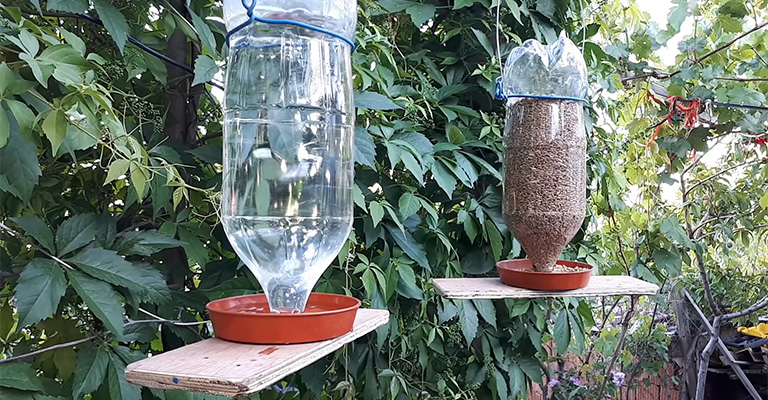
Selecting the Right Bird Feeder
Before you hang the bird feeder or even buy one, you need to learn how to select the right feeder for the birds. Here are a few things you need to consider while choosing the feeder.
Types of Bird Feeders
When it comes to bird feeders for balconies, there are several options to choose from. Here are a few popular types:
Tray Feeders
These feeders have a flat tray-like surface where birdseed is placed. They are ideal for attracting a wide variety of birds, including ground-feeding species. Look for tray feeders that can be securely attached to the balcony railing or have hooks for hanging.
Tube Feeders
Tube feeders have long, cylindrical tubes with multiple feeding ports. They are suitable for attracting small to medium-sized birds like finches and chickadees. Look for tube feeders that can be attached to the balcony railing or have hooks for hanging.
Suet Feeders
Suet feeders are designed to hold blocks or cakes of suet, a high-energy food made from animal fat. These feeders are great for attracting woodpeckers and other suet-loving birds. Look for suet feeders that can be securely attached to the balcony railing or have hooks for hanging.
Size and Capacity of the Feeder
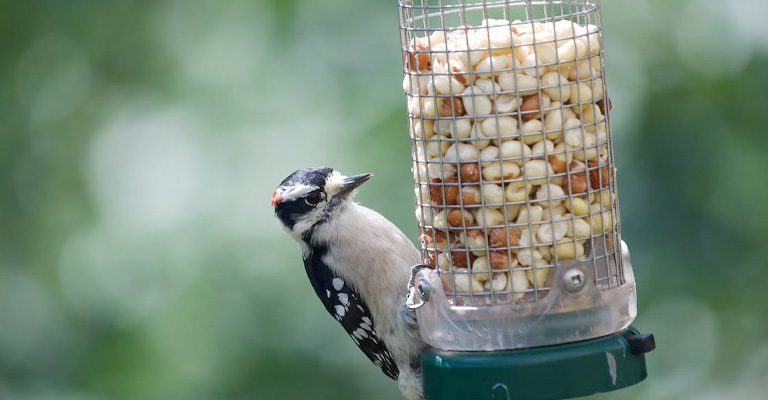
When choosing a bird feeder for your balcony, consider the available space and the number of birds you want to attract. If you have limited space, opt for smaller feeders that can still accommodate a sufficient amount of birdseed or suet.
If you have more space and want to attract a larger number of birds, consider larger feeders with higher capacities.
Additional Features
To ensure the bird feeder is secure and properly hung on your balcony, look for feeders that have specific features for attaching to railings or hooks.
Some feeders come with adjustable clamps or brackets that can be tightened onto the railing, providing stability and preventing them from falling or swaying in the wind.
Other feeders have built-in hooks or hangers that can be easily hung from a balcony railing or hook.
Assessing the Balcony Structure
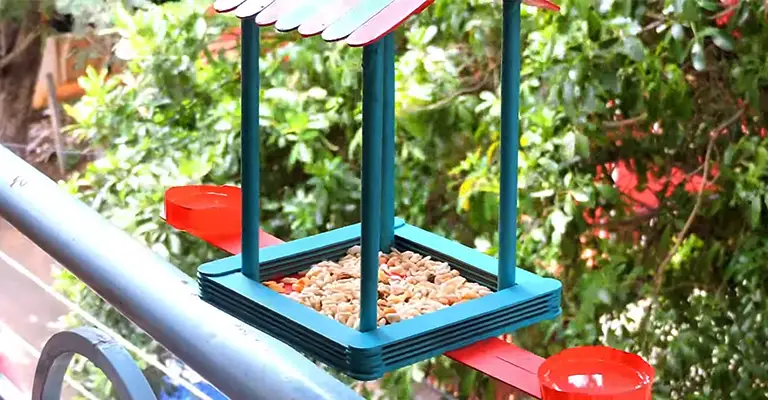
Besides selecting the right bird feeder, the next thing you need to check is the balcony structure. In this case, please follow the below factors.
Checking the Balcony’s Weight-bearing Capacity
Start by evaluating the balcony’s weight-bearing capacity. Balconies are typically designed to support the weight of people, furniture, and planters.
However, adding a bird feeder and the weight of multiple birds may exceed the intended load. Consult your building’s construction plans or contact a professional to determine the weight limit for your balcony.
Consider the materials and construction of your balcony. Concrete or metal balconies are generally more sturdy and capable of handling additional weight compared to wooden ones.
If you are unsure about the weight capacity, err on the side of caution and opt for smaller feeders or limit the amount of food in larger feeders.
Building Management or Landlord
Check with your building management or landlord for any guidelines or restrictions regarding bird feeders on balconies. Some buildings may have specific regulations or policies in place to ensure the safety and cleanliness of the property.
Follow any guidelines provided by the management to avoid potential conflicts and ensure compliance with the rules.
Ensuring the Feeder Attachments Won’t Cause Damage
When attaching the feeder to your balcony, consider the potential for damage to the structure. Avoid methods that may cause permanent damage or compromise the balcony’s integrity.
Look for feeders that have specific attachments designed for balconies, such as clamps or brackets that can be securely fastened without damaging the railing or balcony surface.
If the feeder requires drilling or permanent fixtures, consult with your building management or landlord for approval and guidance.
Alternatively, consider using removable hooks or hangers that can be attached to the balcony railing without causing any damage.
There are various options available that provide stability and security without compromising the balcony’s structure.
Hanging the Bird Feeder
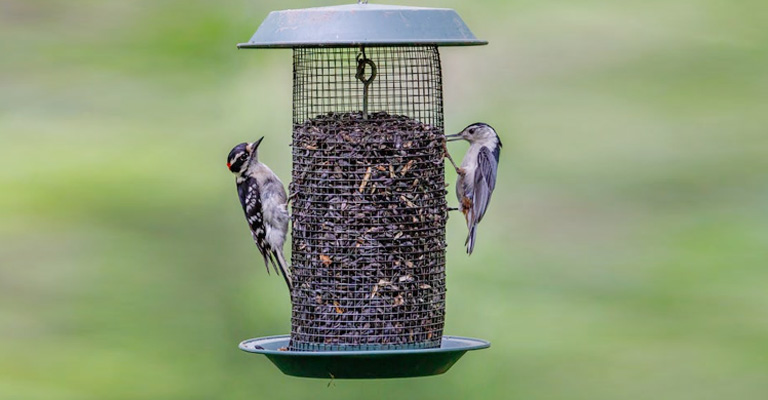
Now, let’s learn about how you should hang the feeder in the right way.
Choosing the Optimal Location for the Feeder
Selecting the right location for your bird feeder is crucial for attracting birds and providing them with a safe feeding environment. Consider the following factors when choosing the optimal location:
Accessibility
Place the feeder in a location that is easily accessible for birds. Ideally, it should be within their sight and reach, allowing them to land and perch comfortably while feeding.
Safety
Avoid placing the feeder too close to windows or glass doors, as birds may become disoriented and collide with the glass. Provide ample space around the feeder for birds to approach and depart safely.
Shelter and Cover
If possible, position the feeder near trees, shrubs, or other vegetation to provide birds with shelter and cover. This helps them feel secure while feeding and provides additional perching spots.
Attaching the Feeder Securely to the Railing or Balcony
Once you have chosen the optimal location, it’s time to attach the feeder securely to the balcony railing or surface. Follow these steps:. . .
Use Appropriate Attachments
Use clamps, brackets, hooks, or hangers that are specifically designed for attaching feeders to balconies. Ensure they are made of sturdy materials and have a secure grip on the railing or balcony surface.
Follow Manufacturer Instructions
Read and follow the manufacturer’s instructions for attaching the feeder to the chosen attachments. Each feeder may have specific guidelines and recommendations for secure installation.
Test for Stability
Before filling the feeder, give it a gentle tug to ensure it is securely attached. Make any necessary adjustments or tighten the attachments if needed.
Ensuring Stability and Safety of the Setup
Ensuring stability and safety is crucial to maintain a successful bird-feeding setup on your balcony. Consider the following:
Regular Maintenance
Check the attachments and feeder periodically to ensure they remain secure. Tighten any loose screws or fasteners as needed.
Weather Considerations
Be mindful of extreme weather conditions, such as strong winds or heavy rainfall, which can potentially dislodge or damage the feeder. Remove or secure the feeder during severe weather to prevent accidents or damage.
Monitor for Any Signs of Damage
Regularly inspect the balcony railing or surface where the feeder is attached for any signs of damage or wear. Address any issues promptly to maintain a safe and stable setup.
Minimizing Mess and Maintenance
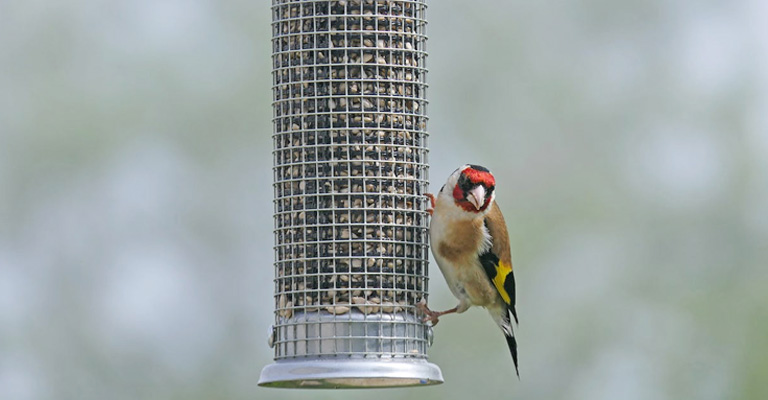
I also want to share some tips that will help you minimize mess and maintenance while hanging the bird feeder.
Using No-mess Feed or Feeders With Catch Trays
One way to minimize mess is by using no-mess bird feed or feeders with catch trays. These options help prevent the accumulation of seed hulls and debris.
No-mess bird feed is usually hulled or shelled, reducing the amount of waste produced by birds. Feeders with catch trays or seed trays can collect fallen seeds and hulls, keeping the balcony cleaner.
When choosing a no-mess feed or a feeder with a catch tray, ensure that it is suitable for the bird species you wish to attract. Different bird species have varying preferences, so select a feed or feeder that suits their dietary needs.
Regular Cleaning and Maintenance of the Feeder and Surrounding Area
Regular cleaning and maintenance are essential for a hygienic and attractive bird-feeding setup. Follow these steps for proper cleaning:
Empty and Clean the Feeder
Regularly empty the feeder and clean it with warm, soapy water. Rinse thoroughly and allow it to dry before refilling. This helps prevent mold, bacteria, and disease transmission.
Clean the Catch Tray or Seed Tray
If your feeder has a catch tray or seed tray, clean it regularly to remove accumulated debris. Dispose of any collected seed hulls, droppings, or moldy seeds.
Sweep or Vacuum the Surrounding Area
Remove fallen seed hulls, bird droppings, and debris from the balcony floor or any nearby surfaces. Use a broom, brush, or vacuum cleaner to keep the area clean and tidy.
Managing Bird Droppings and Debris Effectively:
Bird droppings and debris can accumulate around the feeder and on the balcony. Here are some tips for managing them effectively:
Promptly Clean Bird Droppings
If you notice bird droppings on the balcony, clean them up promptly. Use a mild disinfectant or soapy water and a scrub brush to remove any residue. Rinse the area thoroughly afterward.
Use Bird-friendly Surfaces
Consider using bird-friendly surfaces on your balcony, such as tiles or outdoor mats, which are easier to clean and maintain. Avoid porous materials that can absorb bird droppings and become difficult to clean.
Install Deterrents or Barriers
To minimize debris and droppings on your balcony, consider installing deterrents or barriers that discourage birds from perching or roosting in unwanted areas. These can include spikes, netting, or visual deterrents like reflective objects or wind chimes.
Considering Your Neighbors
Take into consideration the potential concerns your neighbors may have regarding the bird feeder on your balcony. Some common concerns include bird droppings, noise, and potential mess.
Being mindful of these concerns can help maintain a harmonious living environment.
Ensure that the feeder is placed in a location that minimizes the impact on neighboring balconies or common areas. This might involve placing it farther away from other residents or positioning it to direct any potential mess away from shared spaces.
Adjusting Feeder Placement to Minimize Potential Issues
If you receive feedback from neighbors or notice any issues related to the bird feeder, be open to making adjustments. By adopting the feeder’s placement, you can minimize any disturbances or inconveniences experienced by your neighbors.
Consider moving the feeder to a different location on your balcony that reduces the impact on neighboring units or shared spaces. Experiment with different placements until you find a spot that works best for both attracting birds and minimizing potential conflicts.
Communicating and Finding Common Ground With Neighbors
Maintaining open communication with your neighbors can go a long way in resolving concerns related to the bird feeder. Start by being approachable and receptive to feedback.
If a neighbor expresses concerns or discomfort, take the opportunity to have a respectful conversation about potential solutions.
Consider discussing the benefits of the bird feeder, such as its positive impact on bird populations, the joy it brings, or the educational value it offers.
Seek common ground and find compromises that address any concerns while still allowing you to enjoy bird feeding on your balcony.
In some cases, you may need to find a middle ground, such as adjusting feeding times, cleaning more frequently, or implementing additional measures to minimize mess and inconvenience for your neighbors.
Considerations for Hanging a Bird Feeder on a Balcony
| Topic | Consideration |
| Selecting the Right Bird Feeder | Types of bird feeders suitable for balconies |
| Considering the size and capacity of the feeder | |
| Features to look for, such as railing attachments or hooks | |
| Assessing the Balcony Structure | Checking the balcony’s weight-bearing capacity |
| Guidelines from building management or landlord | |
| Ensuring the feeder attachments won’t cause damage | |
| Hanging the Bird Feeder | Choosing the optimal location for the feeder |
| Attaching the feeder securely to the railing or balcony | |
| Ensuring stability and safety of the setup | |
| Minimizing Mess and Maintenance | Using no-mess feed or feeders with catch trays |
| Regular cleaning and maintenance of the feeder and area | |
| Managing bird droppings and debris effectively | |
| Considering Your Neighbors | Being mindful of your neighbors’ concerns |
| Adjusting feeder placement to minimize potential issues | |
| Communicating and finding common ground with neighbors |
FAQs
Yes, you can hang multiple feeders on your balcony if space allows. Ensure that each feeder is properly secured and spaced out to prevent overcrowding and potential conflicts among the birds.
It is recommended to clean the bird feeder regularly to maintain hygiene. Depending on the weather and bird activity, clean the feeder at least once every two weeks or more frequently if needed.
If you notice mold, mildew, or other signs of contamination, clean it immediately.
To attract specific bird species, offer appropriate food and create an inviting environment. Research the preferred food and feeding habits of the birds you want to attract and provide suitable feeders and food options accordingly.
Additionally, consider incorporating plants or water sources that appeal to the desired species.
If you encounter issues with pests, there are several measures you can take. Consider using squirrel-proof feeders that are designed to deter squirrels.
You can also try using baffles or squirrel guards to prevent access. If pigeons become problematic, consider adjusting feeder placement or using feeders designed to discourage larger birds.
Conclusion
Hanging a bird feeder on your balcony can bring joy and beauty while creating a connection with nature.
By selecting the right feeder, assessing the balcony structure, minimizing mess, considering neighbors, and following proper maintenance, you can create a harmonious environment for both birds and residents.
Enjoy the sights and sounds of feathered visitors while fostering a positive living experience. Thank you for your time.